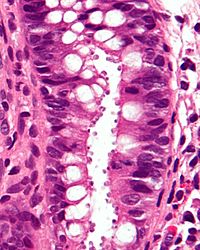
Inhibitory activity of chitosan nanoparticles against Cryptosporidium parvum oocysts
Sign Up to like & getrecommendations! Published in 2019 at "Parasitology Research"
DOI: 10.1007/s00436-019-06364-0
Abstract: Cryptosporidium is a ubiquitous harsh protozoan parasite that resists many disinfectants. It remains viable and infective for a long time in water and food causing global outbreaks. Chitosan (the deacetylated chitin molecule) was used in… read more here.
Keywords: cryptosporidium parvum; chitosan nanoparticles; nanoparticles cryptosporidium; activity chitosan ... See more keywords

Identification of adaptive inhibitors of Cryptosporidium parvum fatty acyl-coenzyme A synthetase isoforms by virtual screening
Sign Up to like & getrecommendations! Published in 2019 at "Parasitology Research"
DOI: 10.1007/s00436-019-06445-0
Abstract: Cryptosporidiosis is a significant cause of gastroenteritis in both humans and livestock in developing countries. The only FDA-approved drug available against the same is nitazoxanide, with questionable efficacy in malnourished children and immunocompromised patients. Recent… read more here.
Keywords: virtual screening; cryptosporidium parvum; acyl coenzyme; coenzyme synthetase ... See more keywords

Multilocus fragment analysis of Cryptosporidium parvum from pre-weaned calves in Colombia.
Sign Up to like & getrecommendations! Published in 2019 at "Acta tropica"
DOI: 10.1016/j.actatropica.2019.02.005
Abstract: The intra-species genetic diversity of Cryptosporidium parvum in dairy cattle farms in the central area of Colombia was investigated using a multilocus fragment typing approach with nine variable-number tandem-repeat (VNTR) loci and the gp60 gene.… read more here.
Keywords: cryptosporidium parvum; pre weaned; analysis; multilocus fragment ... See more keywords

Cryptosporidium parvum in brown brocket (Mazama gouazoubira) from Brazil: First report of the subtype IIaA16G3R1 in cervids.
Sign Up to like & getrecommendations! Published in 2020 at "Parasitology international"
DOI: 10.1016/j.parint.2020.102216
Abstract: This research had as objective to evaluate the occurrence and to characterize genetically the infections by Cryptosporidium in Mazama gouazoubira. By a non-invasive harvest methodology using trained sniffer dogs to locate fecal samples of cervids,… read more here.
Keywords: cryptosporidium parvum; fecal samples; cryptosporidium; gene ... See more keywords

Shedding of Cryptosporidium in calves and dams: evidence of re-infection and shedding of different gp60 subtypes
Sign Up to like & getrecommendations! Published in 2019 at "Parasitology"
DOI: 10.1017/s0031182019000829
Abstract: Abstract One of the most common causes of calf diarrhoea is the parasite Cryptosporidium parvum. Two longitudinal studies were carried out on a dairy farm Scotland to determine the prevalence of Cryptosporidium species and subtypes… read more here.
Keywords: shedding cryptosporidium; infection; cryptosporidium parvum; age ... See more keywords

A simple and efficient transfection protocol for Cryptosporidium parvum using Polyethylenimine (PEI) and Octaarginine
Sign Up to like & getrecommendations! Published in 2020 at "Parasitology"
DOI: 10.1017/s0031182020000724
Abstract: Abstract The transfection of Cryptosporidium represents a major challenge, and current protocols are based on electroporation of freshly excysted sporozoites using a rather large amount of plasmid DNA which typically has a very poor yield.… read more here.
Keywords: transfection; pei; cryptosporidium parvum; octaarginine ... See more keywords

Evaluation of three commercial rapid kits to detect Cryptosporidium parvum in diarrhoeic calf stool
Sign Up to like & getrecommendations! Published in 2018 at "Italian Journal of Animal Science"
DOI: 10.1080/1828051x.2018.1452055
Abstract: Abstract The aim of this study was to evaluate three commercially available rapid immunochromatographic tests for detection of Cryptosporidium parvum antigens in faeces of naturally infected neonatal diarrhoeic calves. FASTest® CRYPTO strip, FASTest® CRYPTO-GIARDIA Strip… read more here.
Keywords: fastest crypto; cryptosporidium parvum; strip; crypto strip ... See more keywords

Evaluation of the BD MAX Enteric Parasite Panel for the detection of Cryptosporidium parvum/hominis, Giardia duodenalis and Entamoeba histolytica
Sign Up to like & getrecommendations! Published in 2017 at "Journal of Medical Microbiology"
DOI: 10.1099/jmm.0.000558
Abstract: Purpose. Conventional laboratory detection methods for gastrointestinal parasites are time consuming, require considerable technical expertise and may suffer from poor analytical sensitivity. This study sought to evaluate the automated BD MAX Enteric Parasite Panel (EPP)… read more here.
Keywords: detection; cryptosporidium parvum; microscopy; duodenalis ... See more keywords

Natural Inactivation of MS2, Poliovirus Type 1 and Cryptosporidium parvum in An Anaerobic and Reduced Aquifer.
Sign Up to like & getrecommendations! Published in 2021 at "Journal of applied microbiology"
DOI: 10.1111/jam.15349
Abstract: AIMS The study of microbial inactivation rates in aquifer systems have most often been determined in aerobic and oxidized systems. This study examined the inactivation (i.e., loss of infectivity) of MS2, poliovirus type 1 (PV1) and Cryptosporidium… read more here.
Keywords: inactivation; cryptosporidium parvum; anaerobic reduced; ms2 ... See more keywords

Recent genetic exchanges and admixture shape the genome and population structure of the zoonotic pathogen Cryptosporidium parvum
Sign Up to like & getrecommendations! Published in 2022 at "Molecular Ecology"
DOI: 10.1111/mec.16556
Abstract: Cryptosporidium parvum is a globally distributed zoonotic pathogen and a major cause of diarrhoeal disease in humans and ruminants. The parasite's life cycle comprises an obligatory sexual phase, during which genetic exchanges can occur between… read more here.
Keywords: cryptosporidium parvum; zoonotic pathogen; genetic exchanges;

Cryptosporidiosis outbreak caused by Cryptosporidium parvum subtype IIdA20G1 in neonatal calves.
Sign Up to like & getrecommendations! Published in 2021 at "Transboundary and emerging diseases"
DOI: 10.1111/tbed.13976
Abstract: Cryptosporidium parvum is a major zoonotic pathogen responsible for outbreaks of severe diarrhea in humans and calves. Almost all investigations of cryptosporidiosis outbreaks caused by C. parvum have focused on its IIa subtype family in… read more here.
Keywords: cryptosporidium parvum; neonatal calves; diarrhea; parvum ... See more keywords